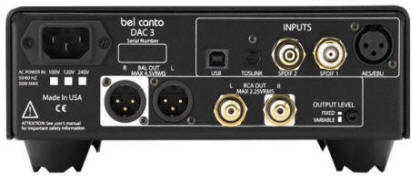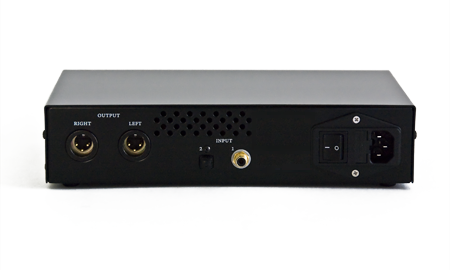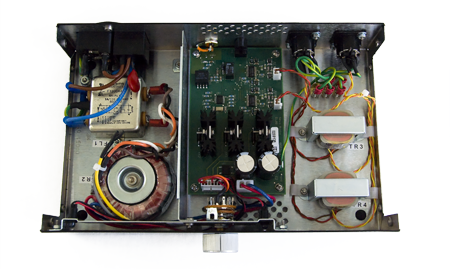|
You are reading the older HTML site Positive Feedback ISSUE 42march/april 2009
A Tale of Two DACs ...the Bel Canto e.One Dac 3 and the Neko Audio D100
These days it's more common to be reviewing DACs than let's say preamplifiers or even phono stages. Maybe that depends on the demographic? Since a lot of analogue-only audiophiles are jumping onto the PC audio craze, DAC manufacturers have had to step it up a bit! In the dark ages, a DAC was usually only connected to the CD transport… Thus only providing a 16bit 44.1 KHz input for Redbook decoding. Now? Almost everything offers "HI-REZ!" Whatever that means, right? Not only that but they come with this strange looking jack called USB. Well not all of them yet, thankfully. Most manufacturers haven't gotten into re-designing their own USB DAC chip, resulting in a maximum of 16bit and 48 KHz, a typical limitation of the audio drivers built into most operating systems. In order to squeeze out more information, one has to take care in writing the code for the chip, ‘sometimes' requiring their own set of drivers. I guess I'm rambling, but I figured I'd at least provide a little background of where I'm going with this. We're kind of in Hi-Rez DAC limbo here folks. Most of these DACs will take in a high resolution signal via their standard inputs: AES, Toslink, S/PDIF Coax, and I2S. I'm still sticking to these inputs unless the manufacturer boasts that they've created their own monster of a USB input (there are only a handful of these out there, but I won't get into that for now.) I own a lot of Hi-Rez recordings, these aren't from any "mastering studio" so take that as you will, these are mainly analogue recordings straight from vinyl. To do this right, it takes a lot of time and patience. Obviously you're recording in real-time, and taking large samples of data so that you don't miss out on any of the magic vinyl has to offer. Well, it's not magic; it's undeniable to prove using a spectrograph of the analogue signal. One can obviously see the supersonics given off by a nicely turned LP. It's just that, who wants to take the time to do this? People like me I guess. I suppose I come from a generation where I am wired two ways; I grew up listening to vinyl, and got my first CD player in 1987. I was young, I'll admit, but I could definitely hear a difference! I was too young to say what was better or not, but I will admit, seeing that laser play music really blew my mind! What's interesting now though is that I can comfortably say that recording vinyl to digital using high-resolution samples really captures that sound I heard years ago, and still today. If carefully done, one can now queue up some "tracks" and have a listen using a remote control to change tracks, but have the sound of the LP! It really is quite nice, and I enjoy doing it. Where I'm getting is, how do these DACs sound with hi-resolution? Almost everyone has heard a decent DAC decoding Redbook audio, and yes they all have their sonic signature. A DAC these days has become the new preamplifier, there are so many out there to try, which one to buy?? I've had a lot come into my home, and incidentally leave just as fast because in my opinion the manufacturer didn't give it their all. The two I'm checking out now are the Bel Canto e.One Dac3, and the Neko Audio D100. Whoa, you say! These DACs are on totally opposite sides of the spectrum, and I will explain why.
The $2495 Bel Canto is in its usual form; small footprint with a minimalistic design like most of their other offerings. It has a green display with a multi-function knob on the right side. Powering it up requires a push of the knob where it then reads out its current firmware revision and it's ready to go in 3 seconds. At this point you can start listening to music; turning its knob allows you to select from its five inputs: AES, Toslink, RCA S/PDIF, BNC S/PDIF, or USB. I got most of my experience using Toslink and USB. I'm sure just from that you can guess that I'm using an Apple iMac as my front-end. The iMac offers a few outputs: firewire, Toslink, and USB. Most Apple products prefer Toslink over coaxial connections most likely because of how they decouple the computer (read: noisy hardware) from the audio decoder. I personally think this is a great idea, but these days most decent equipment manufacturers factor this in during their designs to cancel out any sort of RFI and whatever. I found myself using the Toslink over the USB connection because that is the way I was able to get 24bit 96 KHz straight into the DAC ...and I can listen to my hi-rez recordings at will. Unfortunately Bel Canto's current USB implementation only offers Redbook sampling rates! As mentioned earlier, there are only a handful of engineers out there that have been able to get hi-rez from a USB port; it just takes a bit of design knowledge. I'm sure soon everyone will figure out it, but for now, I'm sticking with the regular inputs. (Bel Canto's 24/96 USB Link is an obvious move in the right direction though Peter did not have access to that device in his audition of the e.One. I would expect Bel Canto to address the USB input on future e.Ones with what they have accomplished in the 24/96 USB Link - Editor) Ok, so if you haven't read up on the Bel Canto yet, it claims to use galvanic isolation on the inputs from the source. This is crucial as there can be a lot of noise picked up from PCs, especially considering their hard drives, clock chips running in hi-frequencies, and sometimes even LCD backlighting that requires step-up transformers into the thousand of volts arena! I can assure you with the Bel Canto, there was no background noise whatsoever; it was very quiet. No strange switching noises from the output stage, no volume clicks, nothing. Oh yes, I mentioned volume …this unit has an output stage large enough to drive your amps directly. For the purists out there, this could be your all in one solution. Couple with a remote control and you're all set! Now, for the people out there that prefer a preamp in the chain (like myself and with tubes thank you) one can set the volume to a static level so that it doesn't change the DAC's outputs. This is done with the flick of a switch on the rear panel. I set it to full output and left it alone. Even so, I will admit I did get curious and connected it directly to my Plinius SA-250 amplifier and wow, what a sound! Of course, there was no tube influence, but it definitely had no issue stepping up its game and becoming the preamplifier for the system. Very clean, clear sound here folks, no BS. It seems though that just about everything out there has blue lights, so this thing stuck out like a sore thumb with its huge green characters. Not a big deal to some people, but might be to others. I did find out later though that the display can be turned off with the remote control. That's nice. Another thing, this device up samples EVERYTHING to 24/96. Everyone out there has a preference, some people like the bit for bit purist approach (like me) and some people prefer up-sampling. Well, essentially up-sampling takes a guess at what would be there if it were 24/96. For some, this creates a "smoother" sound; sort of how SACD sounds. It tends to roll the highs off a bit creating a warmer sound. I think it would have been nice to present the user with the option to up-sample or not, but there is probably a good reason why Bel Canto took this approach. All in all, this is a very solid DAC and I give it a big "thumbs up", especially for the cost. For those out there on a budget and don't care to have a preamp in the mix, it's quite the money saver!
Now, onto the $1295 Neko Audio D100; this little guy really stole the show. With no fancy exterior craziness, most of this devil was in the details. It's really not fair to compare this DAC with the Bel Canto as they are really two completely different beasts. A quick look at the front shows their logo of a cat (Neko = cat in Japanese) and a few blue lights: one for signal lock and the other for power. The lights are a bit on the bright side though ...and there's no way to adjust. Sigh. Ok, let's get onto the good stuff. No USB …no AES/EBU …no I2S …wait a second here. Well, I didn't really care. I don't personally need a DAC that "does it all." I prefer the simplistic approach; optical and coax S/PDIF. These inputs take just about any bit rate out there: 16-24 bit and sampling rates of 44.1-192kHz! I fed it just about any combination and it didn't blink an eye, just a quick blip of the signal lock indicator light and away we went…
The sound? Pure bliss. Simple, no gimmicks… well, the output stage ...maybe. What am I talking about here? Well we'll get to that in a minute, but first he digital stage is really interesting in that it uses a Wolfson chip. This chip has some accolades out there for its ability to do the digital processing with the jitter rejection algorithms already being built in. Great, I mentioned the word jitter… I promised myself I would try to steer clear of that word in this article, but I'm sure someone out there reading this really cares (and probably cares too much.) In my opinion, jitter isn't really an issue anymore ...see, it's been figured out. All manufacturers have their own methods of jitter reduction, but I will say that both of these DACs did a fine job of keeping it at a virtually inaudible (or immeasurable) number. I'll leave it at that.
It then feeds the signal from this processor down to two separate Burr-Brown DAC chips, each one running in mono for complete channel separation; which then leads to the perfect hand off, to two Jensen output transformers. This is where it gets really cool folks, no messy op-amps, no preamplifier stage, just enough to boost the signal to your preamplifier of choice. Nice and simple. Of course, you will get a bit less volume out of this unit, thereby requiring a bit more gain from the preamp, but the results! A clean uncolored sound that is bit-perfect from its source. Because of this, the output is purely balanced ending with two XLR outputs on the rear. There are NO single ended outputs on this baby and that's how I like it. Of course, you can use XLR to RCA convertors and this unit will operate flawlessly but minus the noise cancellation of balanced. Most people don't care about that anyway, a short run of RCAs is usually just as good as XLR but when it comes to PC audio, I want as much outside interference gone from my sound. Currently I'm rocking out to a digital re-master of Queensryche Empire. This was re-mastered using the original tapes by Steve Hoffman and I'll admit he made this one a lot better than the original. Dynamics, slam, lightning fast transients that fill my room from these DACs is more than sufficient to get me goin' with my air guitar! Loving it! The bass-lines in this album really hit me and I am in awe. I've got a few 24/96 vinyl "rips"; for example the original pressing of Sgt. Pepper's and boy it's really spooky. It honestly sounds just like it does from my turntable; these DACs have no problem decoding all of the space, air, and magic contained on these high-resolution files (all in AIFF of course.) Well, in the end both of these DACs performed beautifully. I was equally impressed with either; the Neko for its purest and simplistic approach and the Bel Canto for all of its features packed into one tiny box. With my eyes closed, they both produced an analog output good enough to make me forget I was listening to a 2-channel system. Neko Audio www.nekoaudio.com Bel Canto www.belcantodesign.com
|




